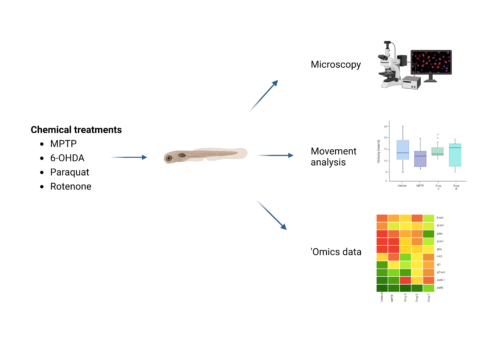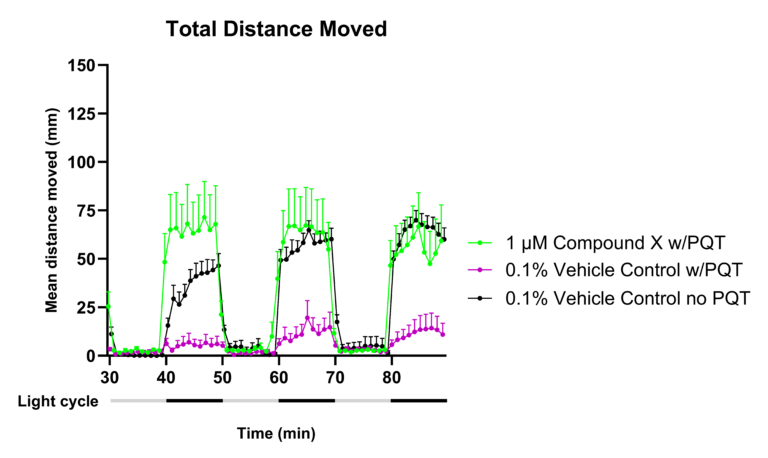Zebrafish Parkinson's Disease Modeling Service
More Disease Modeling Services
Parkinson’s disease is a neurodegenerative disorder that affects the movement of a person. It is caused by the degeneration and death of dopamine-producing neurons in a part of the brain called the substantia nigra. Parkinson’s disease is a chronic and progressive condition that is currently incurable. However, treatments are available that manage symptoms and improve the quality of life.
Zebrafish As A Parkinson's Model
In Parkinson’s disease research, zebrafish have proven to be an invaluable animal model due to their remarkable similarities to humans, including a similar nervous system and genetic makeup. Zebrafish are often used in Parkinson’s research in the following ways:
- Modeling Parkinson’s disease using genetically modified or chemically-treated zebrafish mutants to study the mechanisms underlying Parkinson’s disease and to test potential treatments.
- Identifying potential therapies through drug or compound screening.
- Understanding the genetics of Parkinson’s to study the function of Parkinson’s disease genes and identifing new genes that may be involved in the disease.
Our Comprehensive Approach to Zebrafish Modeling
Zebrafish are transparent during the early development stages, providing researchers a unique window to instantly observe the impacts of various compounds on their neuronal structures.
Larval zebrafish can be a particularly insightful model of Parkinson’s disease (PD) phenotypes because the developing zebrafish nervous system has been extensively studied, and is homologous to many aspects of the human nervous system. The similarities between the human and zebrafish dopaminergic system are especially useful. The zebrafish ventral telencephalon is considered homologous to the mammalian striatum (Stewart et al., 2014), a brain region that plays a critical role in motor and cognitive behaviors, and is connected to the substantia nigra via dopaminergic projections (Redgrave et al., 2010).

Disease Models Creation

Compound Screening

Behavior Assessment/Phenotype measurements
Our Offerings
- For a chemical model, we can expose zebrafish larvae to a chemical that induces a disease-like state and measure phenotypic behavior.
- For a genetically modified model, we can edit the client’s gene of interest to model a specific disease, then measure phenotypic behavior.
Our Services
- Genetically modified zebrafish mutants for modeling Parkinson’s disease.
- Compound screening & behavior assessment.
A chemical approach will be taken to induce Parkinson’s phenotypes. Compound screening can also use genetic models.
Behavior assessments
Age-matched animals from at least two different groups are compared. The animals are recorded responding to stimuli such as light/dark cycling and vibration. The software identifies and tracks animals to quantify many aspects of behavior, including:
- Velocity
- Light/dark Locomotor Reaction
- Vibrational Startle Reflex
- Overall Distance Covered
What data do we provide?
- Locomotory activity: since Parkinson’s is primarily a movement disorder, we provide an overall readout of locomotion.
- Thigmotaxis measurements: a readout of anxiety (a common symptom in Parkinson’s patients).
- Whole mount brain imaging of dopaminergic neurons.
The DanioVision software tracks the behavior of individual zebrafish larvae over time as they explore an arena.
PQT-induced Parkinson’s zebrafish model tested for Luciole Pharmaceuticals.
Compound X Rescues PQT-induced loss of movement. PQT-treated larvae show a strong decrease in locomotion as measured by distance moved during dark stimulation (pink line). In this example, treatment with the test compound induces a recovery of movement (green line) that is comparable to the control phenotype of untreated animals (black line).
Our Method for compound testing and behavior assessment
- Step 1: Dose Optimization of the Client’s Test Compound: determine the appropriate dose(s) of the test compound in the zebrafish model.
- Step 2: Induce Parkinson's Disease Model Genetically or Chemically (MPTP).
-
Step 3: Test the Compound in the Parkinson's Disease Model and Analyze:
-- Behavioral metrics: locomotion, thigmotaxis, startle response
-- Whole mount brain imaging of dopaminergic neurons - Step 4: Genetic Signature Assay (RNASeq): assess changes in gene expression using whole-transcriptome sequencing; gene expression data is subsequently analyzed.
Ready to get started?
Ready to connect with us to learn more about working with our company or our technology?
Submit your inquiry below & we will get back to you soon.



